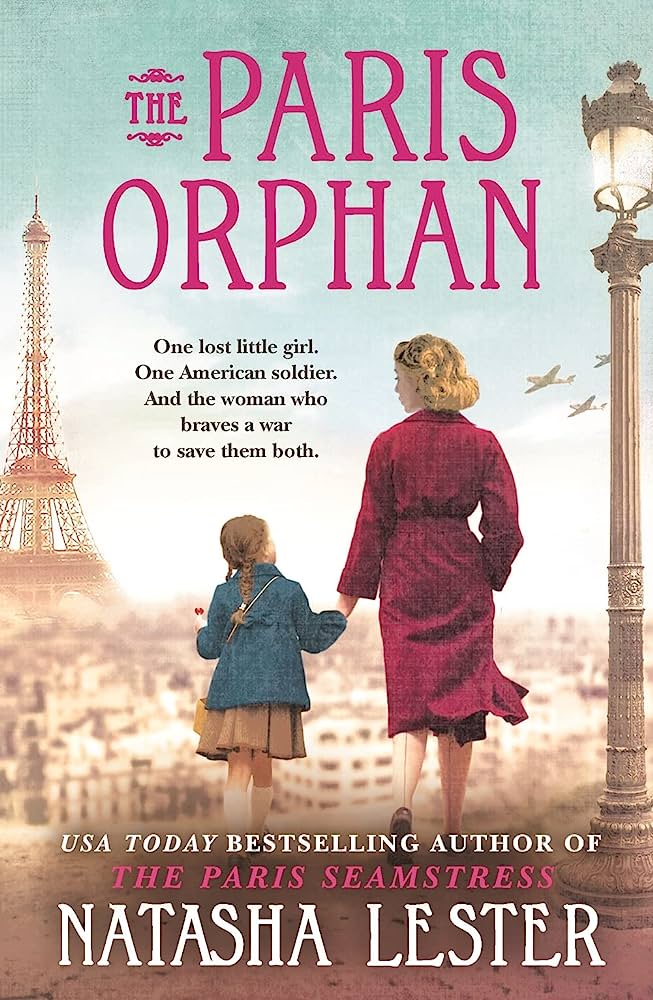
The Paris Orphan
by Natasha Lester
Forever, 2019
Reviewed by Barbara Free, M.A.
The book shifts back and forth between 1942-45 (World War II), and France in 2005, with the characters in World War II and their descendants. This is a bit disconcerting, until it all begins to come together toward the end. It is worth the reader’s time to stick with it until it makes sense.
Jessica May, also called Jess, had previously protested fascism in Paris. By 1942, Germany and Italy had been taken over by Hitler and Mussolini, and Spain was not far behind. Human rights were in danger for everyone. She had been a photographer and a writer as well as a model for Vogue, an upscale women’s magazine. Then a picture of her appeared in McCall’s magazine, in a Kotex ad, without her prior approval or knowledge. She had posed in an evening gown a year before, and her boyfriend, with whom she had been living, sold the photo. That was the end of her modeling career; she was known as “the Kotex girl” from then on!
People were more prudish then than now. This writer remembers just a few years later seeing Modess ads, always picturing a lovely woman in an evening gown, usually white, just saying, “Modess.... because.” I was about nine years old and I wondered what in the world that meant, and asked my mother, who proceeded to tell me all the details of menstruation, except the connection with pregnancy and babies! The incident of the Kotex ad actually did happen to the real Lee Miller, by the way. She broke up with the boyfriend, who had betrayed her and sold the picture. She was 22 years old at the time.
Jessica decided to go to Europe and report on the war. To do that, she had to persuade the State Department to issue her a passport (not as easy as in current times). The people there were not eager to allow a woman into a war zone, even one who spoke French, German, and Italian. Two months later, she did get a passport, but still had to get accredited as a correspondent. The War Department (now the Defense Department) had done research and disapproved of her mother (deceased by then), and had compiled a list of men they speculated Jessica might have slept with, “a pattern of licentiousness.” She asked them if they did the same to men who applied to be war correspondents. Several months later, she did go, and was sent to a field hospital, but wound up in a battle.
The Nazis were not discriminating between hospitals and other areas. She began photographing what she saw. When she finally got to the field hospital, she was accused of disobeying orders and sent back to London, where she was met by a real jerk, Warren Stone, who told her she should only write about “women’s interests, for the women’s pages.” His concern, he said, was that there not proper toilet facilities for women! The photographs she had taken had all been censored and destroyed.
While waiting in London for the situation to change, she met Major Dan Hallworth, who she had encountered during the battle in Italy, and she learned he had stood up for her. Warren Stone tried to blackmail her, unsuccessfully. When she did get to Naples, Major Hallworth took her to a field hospital, where she met a little girl, Victorine, whose parents had been killed when she was a newborn infant. His brother, a doctor, rescued the baby. His wife died in childbirth, as did their child, so he took Victorine to raise. Then he was killed when a shell landed on the operating tent, and Dan Hallworth had become her de facto parent. This was no time for adoption agencies and regulations. By the time Jess met her, Victorine was four years old, living in the field hospital under the care of the nurses and Major Hallworth.
As the book, and war, progress, Jess continues to encounter harassment, discrimination, and danger, especially from Warren Stone. She also gets to know Dan Hallworth better, and is strongly attracted to him, but has made a vow to herself to have no sexual contact while she is in Europe reporting on the war.
The other portions of the book are set in France in 2005, featuring a young woman named D’Arcy, whose mother lives in Australia and is named Victorine. She has raised D’Arcy as a single parent, and has never disclosed the daughter’s parentage, nor anything of her own background. Therefore, D’Arcy knows nothing of her own nor her mother’s biological parentage.
The book is well-written and believable, but it’s hard to credit some of the twists and turns. The story is too convoluted to relate briefly in this review, and too good to ruin by telling how it all comes together. This reviewer recommends it for anyone fifteen or older. It might keep the reader up at night, because it’s hard to put down, even at 430 pages.
Excerpted from the June 2023 edition of the Operation Identity Newsletter
© 2023 Operation Identity